So put your Paws down and Come to Class!
MOVIN ON UP K9 Training
You'll work together with your Instructor to build a lifetime bond with your dog through fun and positive classes!
You'll work together with your Instructor to build a lifetime bond with your dog through fun and positive classes!
Nancy Creal/Auburn California
(Owner and Director of Instructors)
(530.457.7086)

(Owner and Director of Instructors)
(530.457.7086)

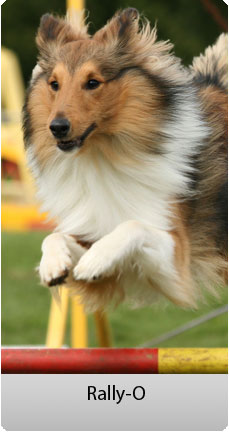
- Rally O/Levels
-
Rally Obedience
Rally Obedience (also known as Rally or Rally-O) is a dog sport based on obedience. It was originally devised by Charles L. "Bud" Kramer from the obedience practice of doing a variety of interesting warm-up and freestyle exercises before an obedience trial. Bud Kramer is also credited with starting Agility in America in the mid 1980's The first concept of Rally was published in America in February 2000, and was adopted by the American Kennel Club in 2005. Since then Rally has spread around the world!
What is Rally?
Rally competitors do not have a judge giving orders. Instead, the competitors proceed around a course that consists of 10 to 20 signs that instruct the team what to do. Unlike traditional obedience, handlers are allowed to encourage their dogs during the course. The only instruction the Handler will get is "Go" after they indicate they are ready, from then on the handler heels the dog between the signs, performing the required actions at the sign without any further communication with the judge.
There are 3 levels; Novice - 10 to 15 stations, Advanced - 12 to 17 stations including 1 jump, and Excellent - 15 to 20 stations, including 2 jumps and an 'Honour' station where the dog will do a stay exercise. All Novice is done on lead, Advanced and Excellent are done off lead, with the exception of the Excellent Honor station being done on lead.
Where does it fit with other dog sports?
Rally Novice is the introductory level and is on a par with the CD obedience class, but because the handler can encourage and praise the dog it is probably a little easier than CD heeling. Many of the techniques used in getting a CD dog's heeling skills up to standard are used as Rally Stations. The concept of walking the course and planning how you will perform each station will be more familiar with Agility trained dogs and handlers.
Rally Advanced takes the Novice skills and bumps them up significantly. It is done off lead and with several stations requiring more advanced skills, it is a little more difficult than the Novice Obedience heeling exercise. However encouragement is still allowed. Some of the stations have exercises that are similar to Dancing With Dogs (DWD) routines, so a DWD background becomes an advantage.
Rally Excellent is the highest individual class that has an even higher level of difficulty which puts the class on a par with Open obedience, with the added requirement to perform more from the DWD discipline. At this level a direct comparison between traditional Obedience and Rally becomes difficult as the requirements have moved away from Obedience and tend towards DWD skills.
After gaining the RE title, a combination of passing Advanced and Excellent on the same day on 10 occasions will earn the title RAE.
Where do I start?
You need to have a dog that will walk on a loose lead, sit, stand, down and come to you on single commands. This will usually be at around the Grade 3 or 4 levels. Although multiple commands are allowed, the dog and handler still have to work as a team, so a dog that will not obey commands should not be regarded as working as a team. The rules for Rally are on the AKC web site. You will need to read and understand these rules. The signs used are shown in the rules, with station. You will be judged on the detail, not just what it says on the sign.
The signs used in Novice are numbered 1 to 31 inclusive. Before entering a Novice trial you should be able to do each one of them as the judge will select 10 to 15 of them to set up the course. No two courses will be the same. Any of the signs can be used in any order.
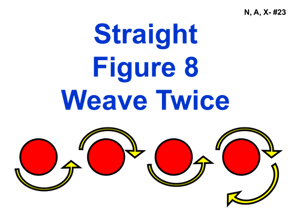
|
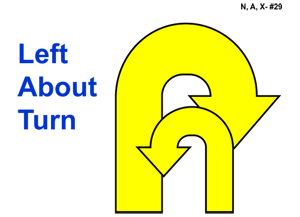
|
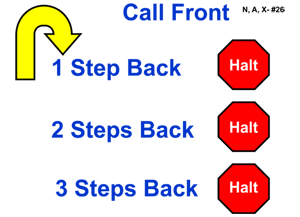
|
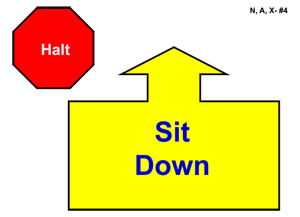
|
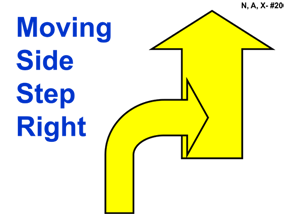
|
Sign Location
In the following, the direction of travel is from the bottom of the page towards the top. The small circle is the sign location; the square represents the area in which it is performed
|
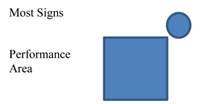
|
|

|
|
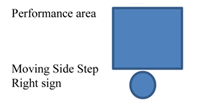
|
- Stations using Pylons/Orange Cones, (Spirals, Serpentines and Weaving) may have the sign on the first Pylon and may require you to pass the sign on your left hand side. They may also have the sign about a meter or more away from the first pylon so that you will pass the sign on your right hand side. The choice is the judge's decision and will be explained at the briefing when you walk the course
Scoring is similar to traditional Obedience. Team work is necessary, which means the dog and handler work together each allowing the other room and time to perform their function. One of the Rally rules is that faults that would be penalised in traditional Obedience will be penalised similarly in Rally. Poor positions, lagging, surging, bumping, crowding, slow response etc. are all penalised. The big difference is you can talk, encourage, even pat your dog, as long as you keep moving at a brisk pace, and the dog is putting in its part of the teamwork.
Each station has a sign that tells the handler what to do. The rules give much more detail on what should happen at the sign than what is on the sign, and you will be scored on how well you do the detail, not just the parts given in the sign. You must read the rules to find out what you must do at each station.
Some signs are designated as Stationary Exercises. This means you must stop when required. Most, but not all, have a Halt sign which means the dog must sit when you stop. If the sign is not a stationary exercise, you must not stop, even to read the sign.
When you do a "walk around the dog" station, you must pause briefly when you get back to the heel position. The pause should be long enough to ensure the judge sees that you have stopped; a couple of seconds should be enough. If you do not pause, it is an Incorrect Performance and will cost 10 points.
When doing a 1 step, 2 steps, 3 steps sign, either forwards or backwards, make sure you take even definite steps. It is amazing how many people lose count when doing these signs, and how many more will shuffle about when trying to stop. If you do too many steps, not enough steps or shuffle around excessively when you stop you will be scored as Incorrect Performance and lose 10 points.
If you do mess up any station, you can take a 3 point penalty and retry that station. Call "Retry" so the judge knows what you are doing, go back to couple of metres before the start of the station and do it again, including the approach from the same direction as the original attempt. You are allowed 2 retries per trial.
Rally is a new sport that will take some time to settle down as Judges, Stewards, Competitors, Trial Managers and Trial Secretaries learn and develop their skills. It has the potential to be a fun yet challenging alternative to Traditional Obedience, with variations and skill sets taken from other sports. Rally should not be regarded as a subset of Obedience, but as a standalone, independent sport.
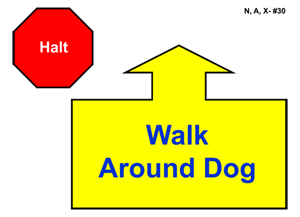
Home | About | Programs | Puppy | Therapy Dog Certification | C.L.A.S.S. | Calendar| Classes & Registration | Contact | Video Ad
